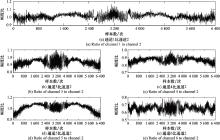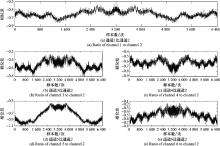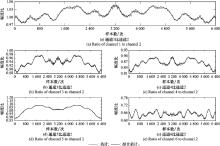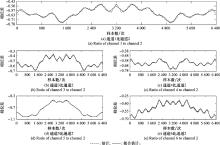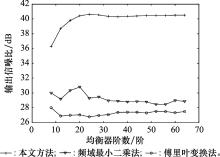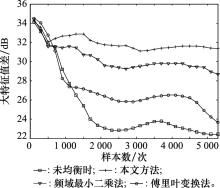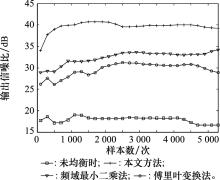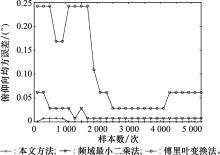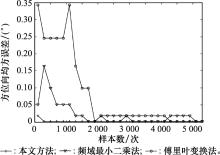| 1 |
YAO Y, HUANG X H, WU G X, et al. Joint equalization and fractional delay filter design for wideband digital beam forming[C]//Proc. of the Radar Conference, 2015: 823-827.
|
| 2 |
THOMPSON D, YEARY M, FULTON C. RF array system equali-zation and true time delay with FPGA hardware-in-the-loop[C]//P roc. of the Symposium on Phased Array Systems and Technology, 2016.
|
| 3 |
TALISA S H , O'HAVER K W , COMBERIATE T M , et al. Benefits of digital phased array radars[J]. Proceedings of the IEEE, 2016, 104 (3): 530- 543.
doi: 10.1109/JPROC.2016.2515842
|
| 4 |
张月, 鲍庆龙, 杨剑, 等. 宽带数字阵列雷达通道均衡方法的设计与实现[J]. 信号处理, 2010, 26 (3): 453- 457.
|
|
ZHANG Y , BAO Q L , YANG J , et al. Design and implementation of channel equalization method for wideband digital array radar[J]. Journal of Signal Processing, 2010, 26 (3): 453- 457.
|
| 5 |
LI W L, MU S X, LIU F. Channel equalization based convex optimization[C]//Proc. of the International Conference on Wireless Communications & Signal Processing, 2015.
|
| 6 |
LIANG Z N , LIU Q H , LONG T . A novel subarray digital modulation technique for wideband phased array radar[J]. IEEE Trans.on Instrumentation and Measurement, 2020, 69 (10): 7365- 7376.
doi: 10.1109/TIM.2020.2984417
|
| 7 |
ZHOU Y S , WANG R , DENG Y K , et al. A novel approach to Doppler centroid and channel errors estimation in szimuth multi-channel SAR[J]. IEEE Trans.on Geoscience and Remote Sensing, 2019, 57 (11): 8430- 8444.
doi: 10.1109/TGRS.2019.2921094
|
| 8 |
WU D , ZHANG Y D , ZHU D Y , et al. A channel calibration algorithm based on isolated scatterers for multi-channel HRWS-SAR[J]. IEEE Access, 2019, 7, 135665- 135677.
doi: 10.1109/ACCESS.2019.2941203
|
| 9 |
KUNMING Z, YANG Z, LEICHEN Z, et al. Adjustment for amplitude and phase mismatch of I/Q channels[C]//Proc. of the IET International Radar Conference, 2015.
|
| 10 |
LU Z K , NIE J W , WAN Y D , et al. Optimal reference element for interference suppression in GNSS antenna arrays under channel mismatch[J]. IET Radar, Sonar & Navigation, 2017, 11 (7): 1161- 1169.
|
| 11 |
KRICHENE H A, HO M T, TALISA S H, et al. Effects of channel mismatch and phase noise on jamming cancellati on[C]//Proc. of the IEEE Radar Conference, 2014: 38-43.
|
| 12 |
LEI P Z, ZHOU H, HUANG X T. Multi-channel equalization for SAR/GMTI system with small time-bandwidth c hirp signal[C]//Proc. of IEEE the CIE International Conference on Radar, 2011: 707-710.
|
| 13 |
LU Z K, CHEN F Q, XIE Y C, et al. Impact on anti-jamming performance of GNSS signal bandwidth under channel mismatch used antenna arrays[C]//Proc. of the International Conference on Computer and Communication Systems, 2020: 717-722.
|
| 14 |
GAO F, WANG Y L, CHEN H, et al. Effect of channel mismatch on STAP performance[C]//Proc. of the Congress on Image and Signal Processing, 2008: 85-89.
|
| 15 |
MEDLEY J C, DACKE F C, ADAMS F J. The impact of channel dispersion errors and equalization filtering on subarrayed adaptive beamforming[C]//Proc. of the IEEE International Radar Conference, 2005: 703-708.
|
| 16 |
彭小亮, 李荣锋, 王永良, 等. 两种修正的自适应通道均衡方法[J]. 电子与信息学报, 2006, 28 (4): 658- 662.
|
|
PENG X L , LI R F , WANG Y L , et al. Two methods of modified adaptive channel equalization[J]. Journal of Electronics & Information Technology, 2006, 28 (4): 658- 662.
|
| 17 |
LAKE J, YEARY M. PALMER R. Real-time digital equalization to enhance element-level digital beamforming[C]//Proc. of the IEEE Radar Conference, 2019.
|
| 18 |
LU Z , CHEN H , CHEN F , et al. Blind adaptive channel mismatch equalization method for GNSS antenna arrays[J]. IET Radar, Sonar & Navigation, 2018, 12 (4): 383- 389.
|
| 19 |
DENG L , HUANG Y M , CHEN Q , et al. Collaborative blind equalization for time-varying OFDM applications enabled by normalized least mean and recursive square methodologies[J]. IEEE Access, 2020, 8, 103073- 103087.
doi: 10.1109/ACCESS.2020.2999387
|
| 20 |
MOHANTY M, KANNADASAN P, SARKAR B K, et al. Cumulant based blind channel estimation and equalization in aeronautical telemetry channel[C]//Proc. of the International Conference on Range Technology, 2019.
|
| 21 |
YU L Q , WANG N , LIU G Q , et al. Channel equalization method for wideband digital array radar[J]. The Journal of Engineering, 2019, (3): 7779- 7782.
|
| 22 |
WANG Y, LI H Y, DONG X L. A suitable channel equalization method for navigation system[C]//Proc. of the International Conference on Computational Problem-Solving, 2013: 283-286.
|
| 23 |
LUO X Q, ZHANG Z Y. Transform domain equalization for doubly selective channels[C]//Proc. of the IEEE 89th Vehicular Technology Conference, 2019.
|
| 24 |
LIU Y Y , LI Z F , YANG T L , et al. An adaptively weighted least square estimation method of channel mismatches in phase for multichannel SAR systems in azimuth[J]. IEEE Geoscience and Remote Sensing Letters, 2014, 11 (2): 439- 443.
doi: 10.1109/LGRS.2013.2264771
|
| 25 |
龚博文, 姚志成, 杨剑, 等. 数字阵列雷达通道均衡技术研究[J]. 现代防御技术, 2018, 46 (5): 75- 81.
|
|
GONG B W , YAO Z C , YANG J , et al. Digital array radar channel equalization[J]. Modern Defense Technology, 2018, 46 (5): 75- 81.
|
| 26 |
魏文斌, 江晶. 一种有效的阈值反卷积算法[J]. 电子学报, 2005, 33 (z1): 2531- 2534.
|
|
WEI W B , JIANG J . An efficient threshdold deconvolution al gorithm[J]. Acta Electronica Sinica, 2005, 33 (z1): 2531- 2534.
|
| 27 |
RAN Y, WANG X G, ZOU L. Performance of the improved channel equalization method for wideband digital array radar[C]//Proc. of the International Conference on Communications, Circuits and Systems, 2009: 443-445.
|


